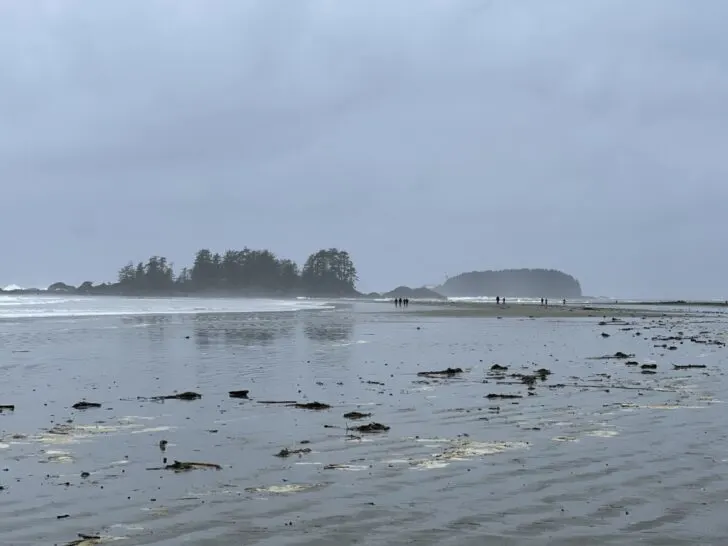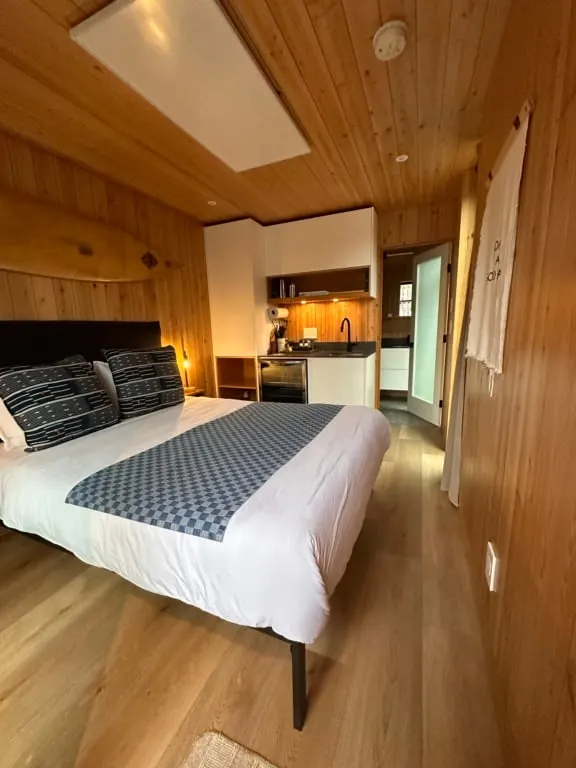Known as Načiks in Nuu-chah-nulth, Tofino is one of the most beautiful spots on Vancouver Island: lush rainforests, sandy beaches, and a quaint coastal town. It’s certainly not a mainstream opinion, but I prefer visiting Tofino in winter.
As a little kid, I spent a few summers in Tofino with my extended family, building sand castles in Cox Bay. But as an adult, I’ve returned to Tofino over and over in the winter months. I think it’s the perfect cozy getaway for hikers, foodies, and people who love stunning coastal scenery.
There’s something special about curling up in a cabin, listening to the rain drum on the roof while the waves crash outside. I love going for a walk on the beach while the fog swirls around me or hiking through the cedar forests admiring the water droplets clinging to the moss and ferns.
In this post, I’ve got everything you need to know about visiting Tofino in the winter (and by extension the spring and fall too.)
This post includes:
- Why visit Tofino in winter? I explain why I love it.
- Map of Tofino that includes all the places I mention in this post.
- Best things to do in Tofino in the winter: rainforest hikes, surfing, kayaking, storm watching, and more
- Where to eat in Tofino: My picks for the best coffee shops, food trucks, and restaurants
- Where to stay in Tofino: My picks for the best hotels and resorts.
- Winter in Tofino basics: How to get there? How long to spend? What’s the weather like? And lots more.
This is a sensitive wilderness area. Learn how to Leave No Trace to keep the wilderness wild. Make sure you are prepared by bringing the 10 Essentials. Get ready for adventure with this checklist of things to do before every hike.
Hey there: Thanks so much to Tourism Tofino for hosting some of my experiences during my most recent trip to Tofino. My previous trips were not hosted and all opinions in this post are my own. Some of the links in this post are affiliate links, which means I earn a small commission at no cost to you. Thanks for your support. -Taryn
Why Visit Tofino in Winter?
Tofino is one of the most popular tourist destinations on Vancouver Island. The tiny town of 3,000 residents hosts about 600,000 visitors each year. But… most of those people come in the summer between May and September.
If you come in the winter, or anytime between October and April, you’ll see the real Tofino that locals know, without the crowds. (If you look at my photos in this post, you’ll notice that there are hardly any people in them. That’s not because I did the travel blogger trick of trying to shoot around people. That’s because there was hardly anyone around!)
It’s quiet and cozy in Tofino when the temperature drops and the rains roll in, but it’s beautiful too. Tofino is part of the UNESCO Clayoquot Biosphere Region, which recognizes its unique ecosystem, fed by rains and powerful coastal weather.
And winter is the time to really appreciate that unique ecology. The rainforests seem to glow even brighter green as they suck up all that moisture. The power of storms crashing against the coast is an unforgettable sight. And when the sun does come out, it feels extra special.

Vising outside of the summer season helps contribute to sustainable tourism as well. You will be supporting the local economy and reducing the impacts of over-tourism. For example, in the summer Tofino often struggles with drinking water shortages, exacerbated by the huge influx of tourists. In the winter, the ample rainfall means that’s not a problem.
But one of the big reasons to visit in winter is a practical one – it’s much more affordable. Accommodation prices can be more than twice as much in the summer compared to the off-season. And while some businesses and tour operators close over the winter, most are still open each weekend, often with reduced winter pricing.
Map of Tofino
To help you find your way around, I made this custom Google Map of Tofino for you. It includes every single place I mention in this post.
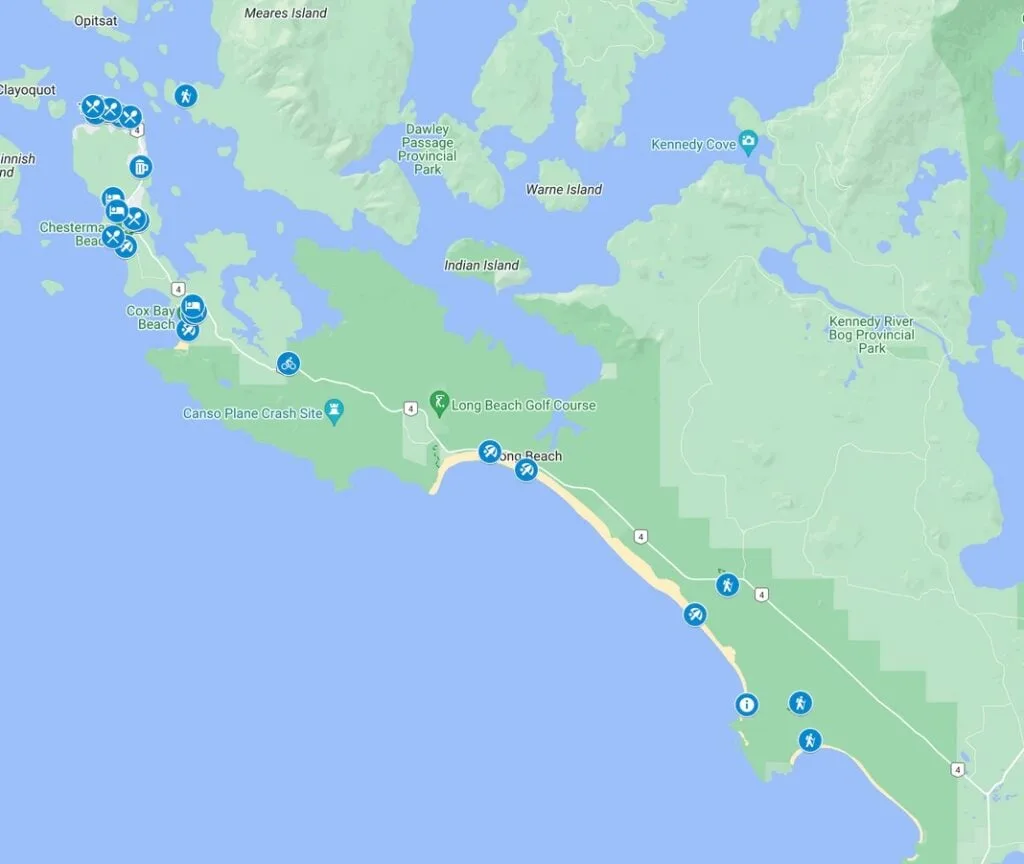
Things to Do in Tofino in Winter
You might be surprised to hear that you can do pretty much all of the same activities in winter in Tofino as you can in the summer. There are a few exceptions of course: You can’t go whale watching or bear watching since most of the whales have migrated elsewhere and the bears are asleep. And you might not want to spend time frolicking on the beach in your bathing suit!
But pretty much everything else is open and available. In my list of recommendations below I’ve added notes and tips for winter such as info on reduced hours.
Rainforest Hiking
One of the things that makes Tofino so unique is that it is one of the easiest places to access Vancouver Island’s incredible coastal rainforest.
The coastal rainforests of British Columbia are some of the wettest areas on Earth outside of the tropics. Winter rains bring the most moisture to the forests, so that’s the best time to visit since everything is at its most lush and green.
There are lots of short and easy trails where you can walk between giant trees covered in moss and ferns. (If you’re looking for a more challenging way to see the rainforest, you can hike the nearby West Coast Trail.)
The Rainforest Trail in Pacific Rim National Park is one of the best places to get a feel for this unique ecosystem. There are actually two short loop trails, both 1 km long, on either side of the Highway. Be sure to pay National Park entry fees in the parking lot.
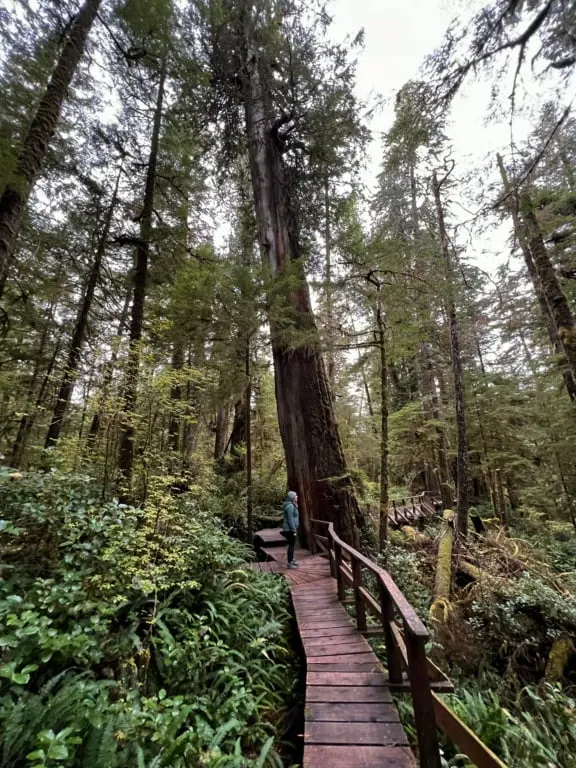
Both are gorgeous, but Loop A on the north side of the Highway includes a huge cedar with signature Parks Canada red chairs to enjoy the view. While both of these trails are easy, they do include quite a few stairs. As well, both trails are almost entirely on wooden boardwalks, which can be slippery.
If you’re looking for more rainforest hikes, I also recommend Shorepine Bog Trail and Nuu-chah-nulth Trail, both of which are also in Pacific Rim National Park. The Big Tree Trail on Meares Island is another great option – more about that below.
Storm Watching
Since Tofino’s West Coast is open to the Pacific Ocean, they get huge waves when winter storms roll in. Most of the time if I travel somewhere and there is a huge storm, I grumble. But in Tofino, I love it because watching the storms hit the coast is so cool. Think gale-force winds, driving rain, and giant crashing waves.
Storm Watching Beaches
The easiest way to go storm watching is to go for a walk along one of Tofino’s beaches.
Chesterman Beach is my favourite because you can watch waves breaking across Frank Island in the centre of the beach or on the rocks at the north end.
Cox Bay Beach and Long Beach (especially near Incinerator Rock) are also great.
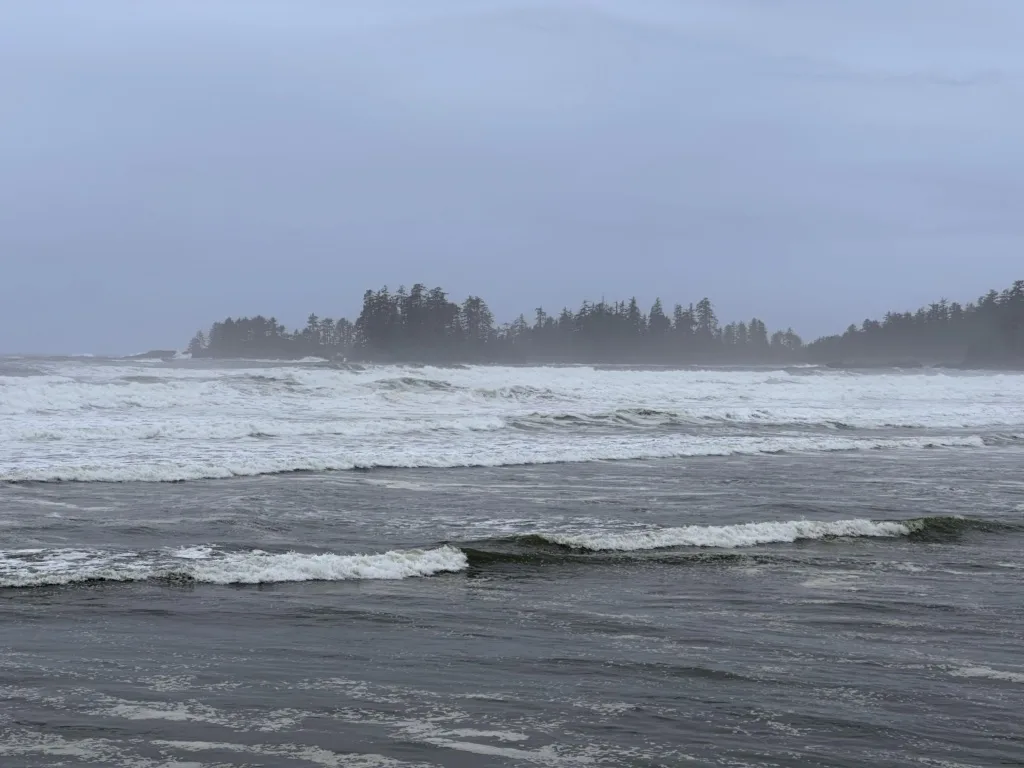
Wild Pacific Trail
It’s also worth heading south to Ucluelet to watch the waves from the Wild Pacific Trail. The Lighthouse Loop section is the most popular, but I like the quieter Artist Loops on the section of trail between Brown’s Beach and Rocky Bluffs.
I’ve got a full description of this trail including tips for the best viewpoints in my book, Backpacking on Vancouver Island.
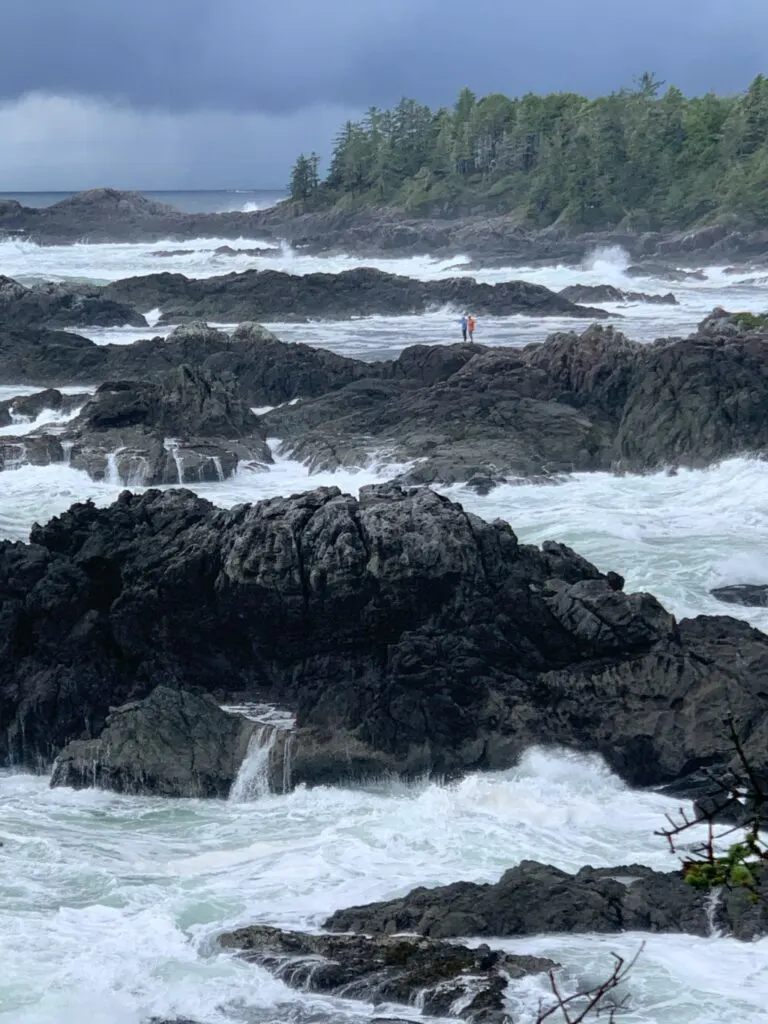
Kwistitis Visitor Centre
The Kwisitis Visitor Centre on Wickaninnish Beach in Pacific Rim National Park is also great for storm watching. You can walk along the beach or take in the view from the outside deck.
One of the best dry places to storm watch is hidden inside the visitor centre – find it up the stairs from the exhibits. (The exhibits about local Indigenous languages are also awesome BTW.)
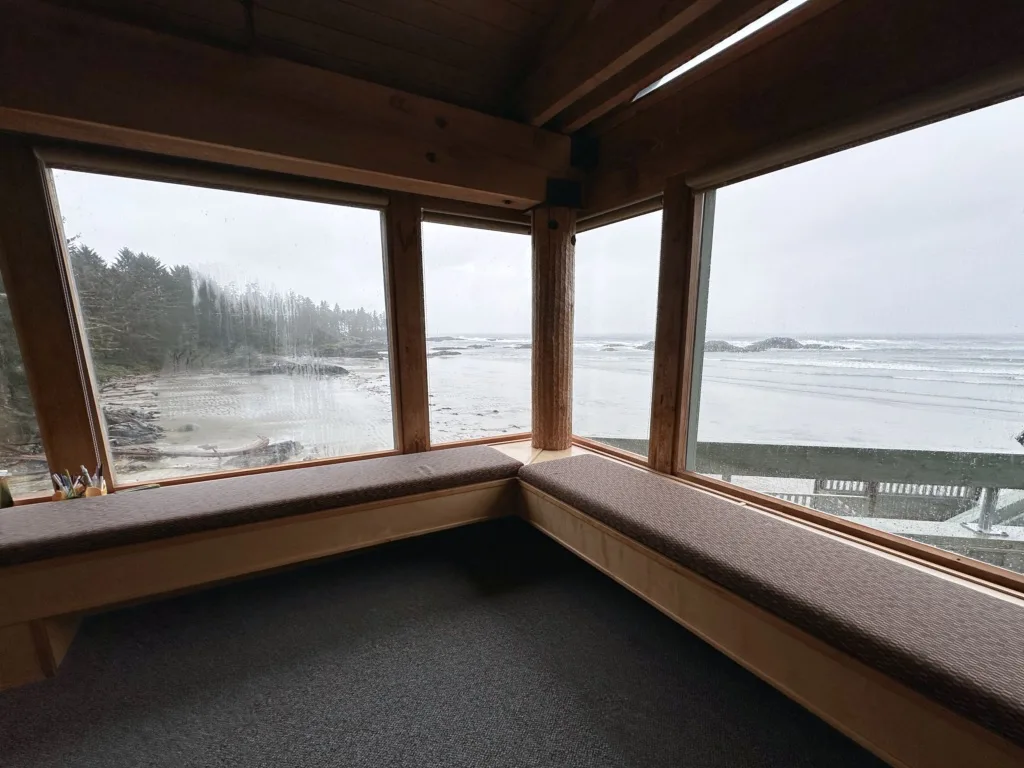
Storm Watching Restaurants
If you want to stay dry and cozy while storm watching, a few of the oceanside resorts provide prime viewing from their restaurants. The Pointe Restaurant at the Wickaninnish Inn on Chesterman Beach and The Great Room at Long Beach Lodge on Cox Bay let you dine in style while enjoying the storm.
Storm Watching Safety
If a storm hits while you are in Tofino, head to the coast to watch it. BUT keep safety in mind.
Check the tide table so you don’t get stranded by incoming water.
It’s tempting to stand on rocky outcrops to watch. But that’s where big waves hit unexpectedly. These waves are sometimes called ‘rogue waves’ or ‘sneaker waves’ – they can sweep people out to see.
Lastly, watch out for driftwood. If a big wave comes in all those beach logs turn into floating torpedos that can hurt you. Don’t stand near them!
Hot Springs Cove
If you’re looking for a unique adventure, head to Hot Springs Cove, known as Mux̣šiƛa in Nuu-chah-nulth. This is one of the most unique hot springs in Canada and have been on my bucket list for a long time.
The springs are in the traditional territory of the Ahousaht Nation (a member of the Nuu-chah-nulth Tribal Council) and today they are co-managed by BC Parks and the Nation.
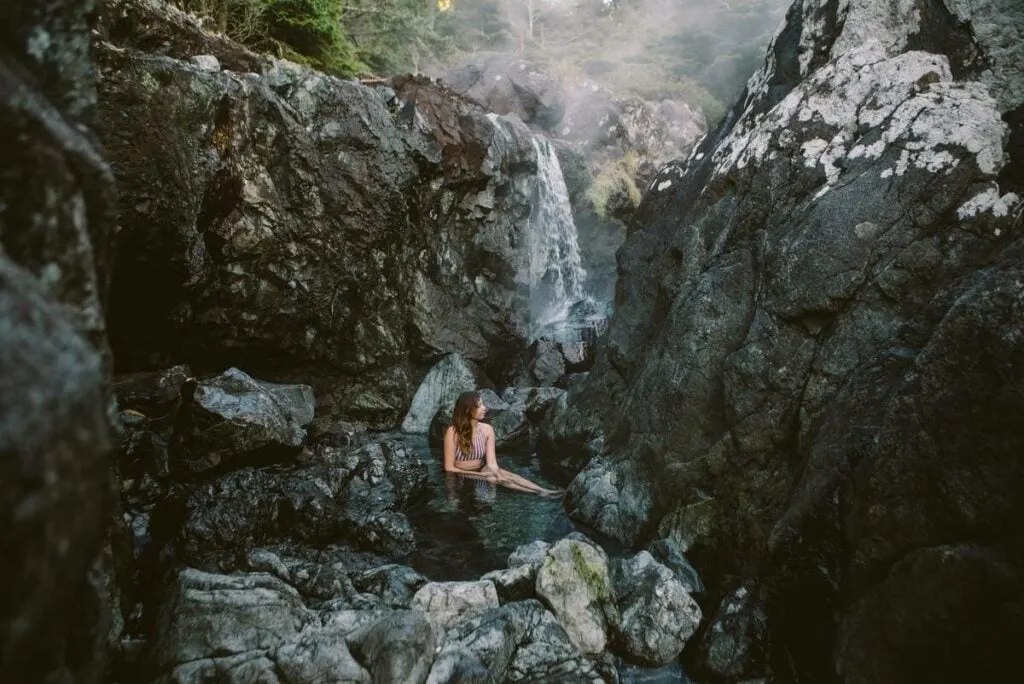
The only way to Hot Springs Cove is via boat or seaplane, so you will need to go with a tour. I recommend Ahous Adventures, an Ahousaht-owned tour company.
Once you arrive, you’ll walk 2 km through the rainforest along a boardwalk to the springs. The water bubbles up through the rocks into small, natural pools before trickling into the ocean.
If you’re booking a hot springs tour in the winter, be prepared for the possibility of rough weather. Bring seasickness medication just in case.
And if the weather is too rough, the tour company will cancel your tour and refund you – that’s what happened to me on my most recent trip. A huge storm rolled through the day I was booked to go!
I recommend booking your Hot Springs Cove tour for the beginning of your trip – that way if it gets cancelled due to weather you may be able to rebook later in your stay.
Surfing
Tofino is considered the best place to surf in Canada. The waves roll in from the open Pacific Ocean, breaking on sandy beaches. In the winter, the waves are larger, making for exciting surfing.
If you want to watch surfers do tricks in the waves, winter is a great time to visit. Stroll along Cox Bay Beach or Chesterman Beach and admire the experienced surfers riding the break.
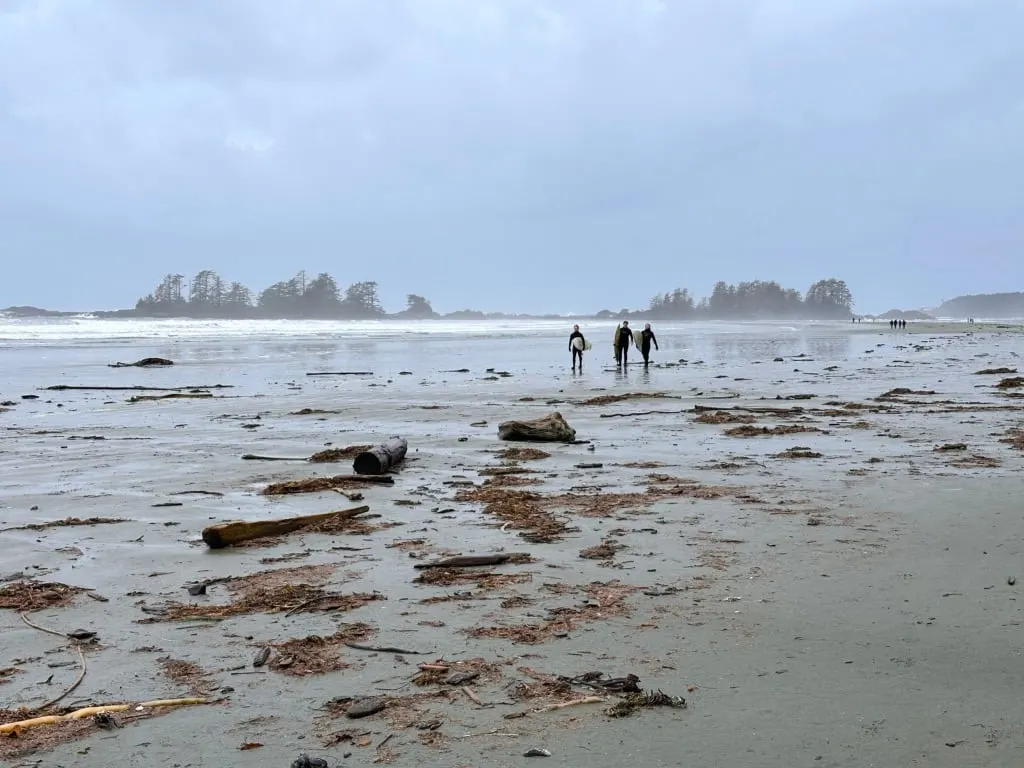
On my first few visits to Tofino, I watched the surfers with interest, but I wasn’t sure if I was ready to try surfing. But… on my most recent visit, I took a lesson with Pacific Surf Co. I was definitely nervous, but in the end, I had tons of fun!
With the cold temperatures, I was worried about being freezing, but they decked us out in thick wetsuits, gloves, booties, and neoprene hoods. I actually ended up taking my hood off since it was a bit too hot!
The big winter waves were also a concern. But our instructor took us to a spot with smaller waves and a long, shallow, sandy beach. I was never in water over my waist, but I still had lots of time to try to stand up on my board before I ran out of ocean. Our instructor told us that except for a few days a year with huge storms, they can always find a beginner-friendly place to surf.
While I didn’t manage to stand up on my surfboard, I got up to my knees quite a few times. My husband got all the way up, which was really exciting. The lesson was lots of fun, but also exhausting. And now I’m googling surf vacations… so I think maybe I’m hooked?
If you’re planning to surf in Tofino in the winter, I definitely recommend taking a lesson. I learned a lot and wouldn’t have known what to do without it. Since it was winter, we had a small group so we each got lots of attention from the instructor. Also, it is so much safer than going on your own.
Kayaking
While Tofino’s west coast has huge waves coming off the Pacific, the east coast in Tofino Harbour has calm and protected waters that are great for kayaking year-round.
On my most recent trip, I went on a kayak tour with Paddle West Kayaking. We paddled around the islands in Tofino’s harbour, watching for eagles, and spotting sea stars beneath the surface. When we started out it was a bit misty and cloudy, but by the time we returned, the sun had broken through. What a beautiful day on the water!
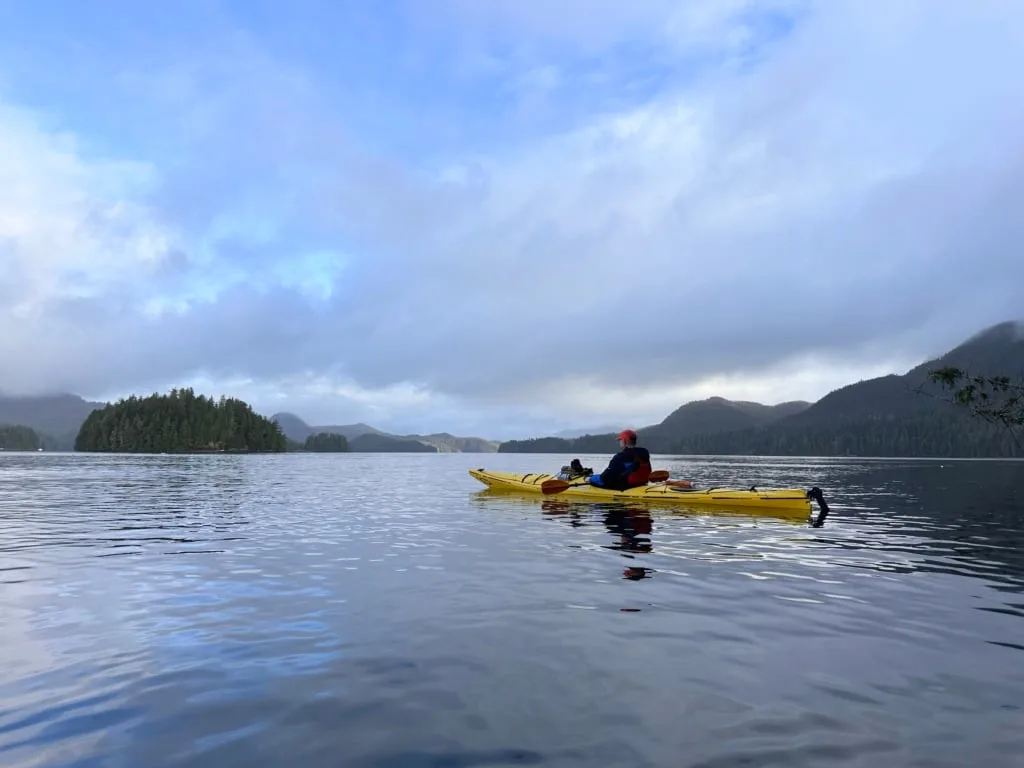

The tour I took was really beginner-friendly: they provided all the gear, gave us paddling tips, and kept us in calm water with minimal currents. I’m not a kayaking beginner (I’ve been kayaking lots of times and even did a multi-day kayaking trip in the Johnstone Strait on northern Vancouver Island), but I still had a great time.
If you want to go kayaking in the winter, keep in mind that there are fewer tours offered each week. On the day I went the water was calm, so I opted for a single kayak. But if you’re a real beginner or the water isn’t that calm, ask to go in a double kayak. They are more stable and you can share the load of paddling.
Big Tree Trail on Meares Island
If you want to see some of the oldest and biggest trees in the coastal rainforest near Tofino, head to the Big Tree Trail on Meares Island. The 3.5 km-long loop trail includes towering Sitka spruce, western hemlock, and western red cedar trees.
Since it’s on an island, you’ll need to take a boat to get there. Several local water taxi companies run trips over to the island a few times a day. That’s how I got to Meares the first time I went. But last time I was in Tofino, I took a kayak tour that also visited part of the Big Tree Trail.
Meares Island was slated for logging in the 1980s and 90s, but was saved thanks to protesters. Today, the trail is inside the Tla-o-qui-aht Nation’s Meares Island Tribal Park, also known as Wanachus-Hilthuuis. Part of your water taxi or kayak fees go to the Tribal Park.
The trail undulates through the rainforest on a series of hand-hewn boardwalks, which can be slippery and uneven. Stay on the boardwalk to avoid damaging the fragile root systems of the ancient trees, some of which are 2000 years old. You’ll pass several huge trees including the Cedar of Life and the Hanging Garden Tree.
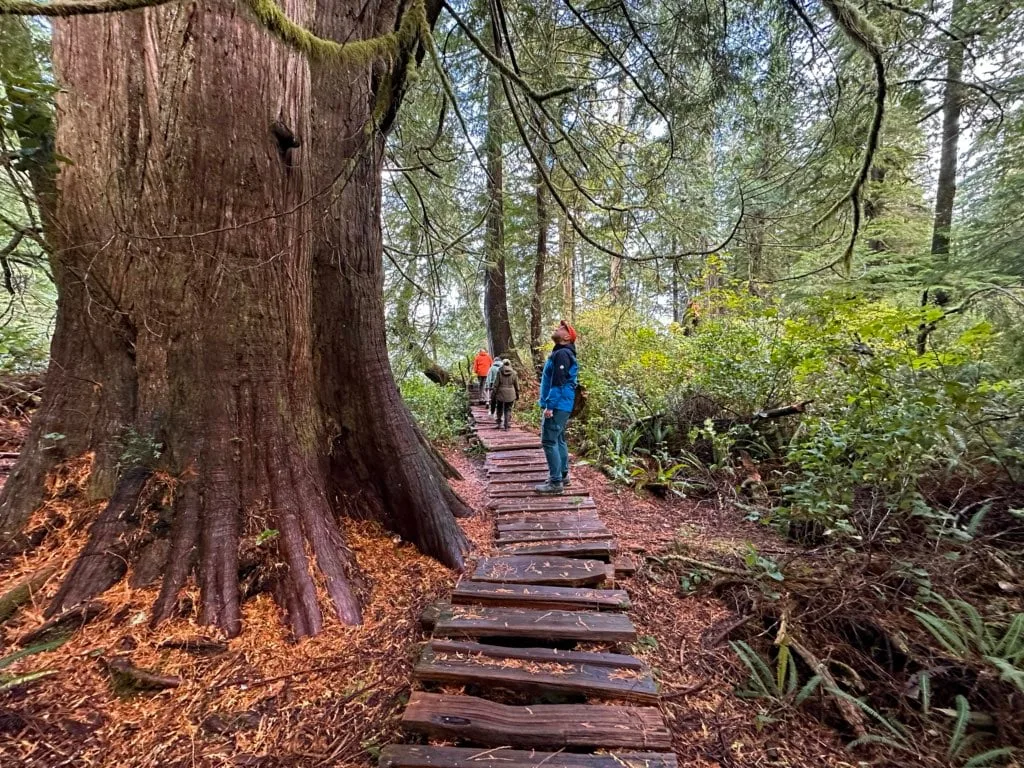
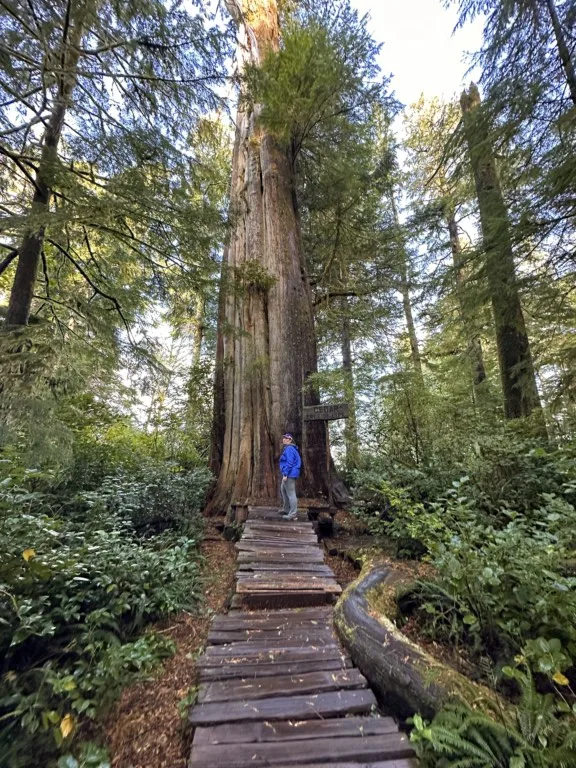
I love visiting these stately giants. There is something very humbling about visiting trees that have witnessed so much. Read my full guide to the Big Trail Trail and visiting Meares Island.
Beach Walks
One of my favourite things to do in Tofino is to just go on a walk along the beach. It’s a really popular activity and you’ll see people out walking on the beaches every day of the year in almost any weather.
Most of the beaches are packed sand, which makes for easy walking and often have rocky outcrops to explore. With the tide and the waves, the beaches are always changing so there is something new to see each time I visit. Check the tide table to see if the tide is rising or falling so you don’t get stuck on offshore rocks!
If you’re going to walk on the beaches in winter, wear waterproof shoes. Don’t forget a rain jacket even if it looks nice – the clouds can blow in quickly.
To get to most of the beaches you park, and then walk down a marked access trail to the beach. In the summer parking can be super busy, but you won’t have trouble finding a spot in the winter. Just be sure to pay your parking fees!
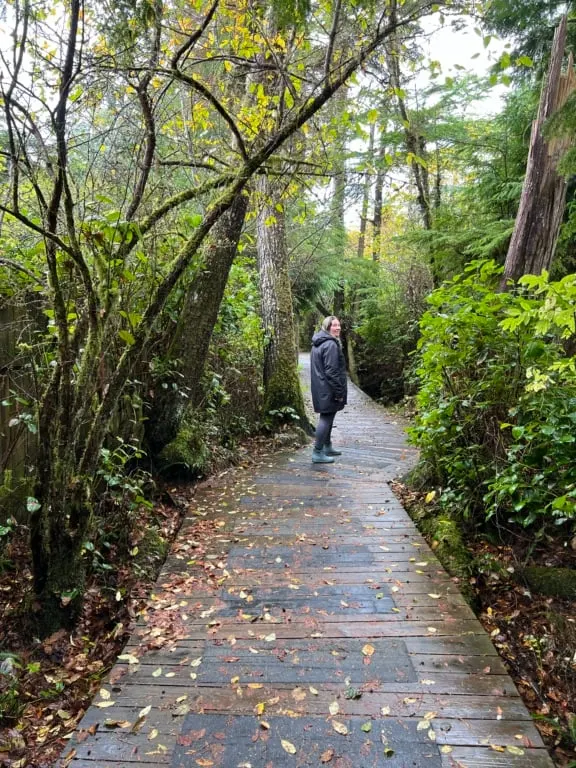
You can’t go wrong with a walk on any of the beaches in Tofino. They each have their own charm. Mackenzie Beach is one of the smallest. Chesterman Beach is split in half by the tombolo out to Frank Island in the middle. Cox Bay Beach has the biggest waves. Long Beach is… long! And Wickaninnish Beach has some unique (and ecologically fragile) sand dunes.
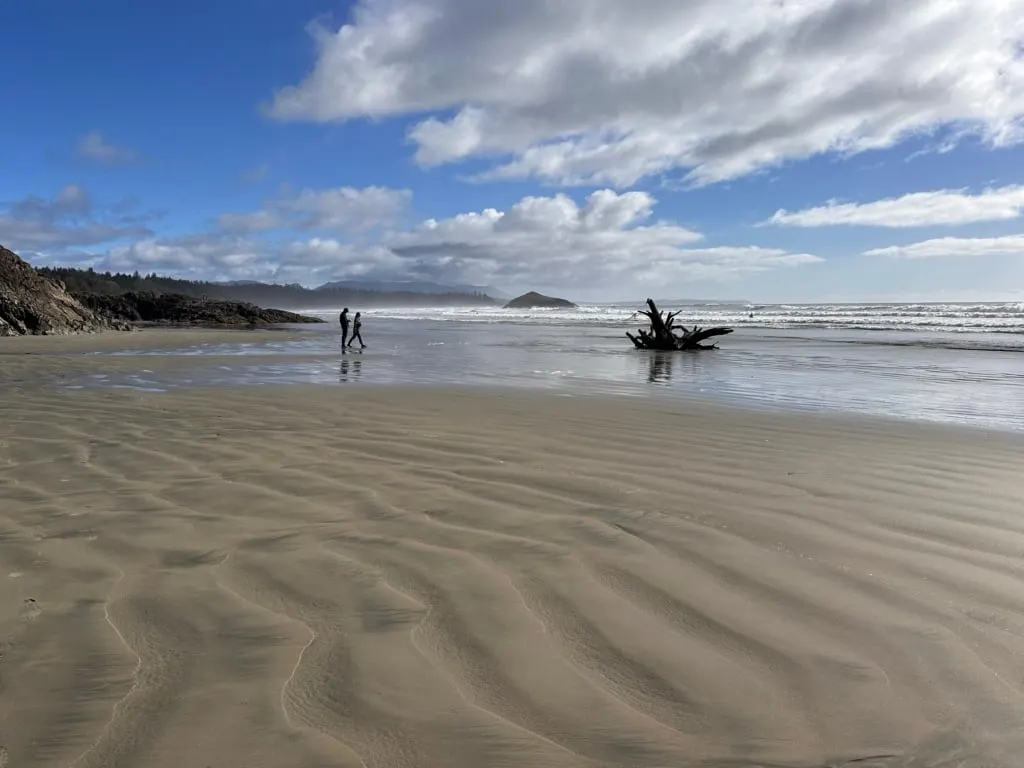
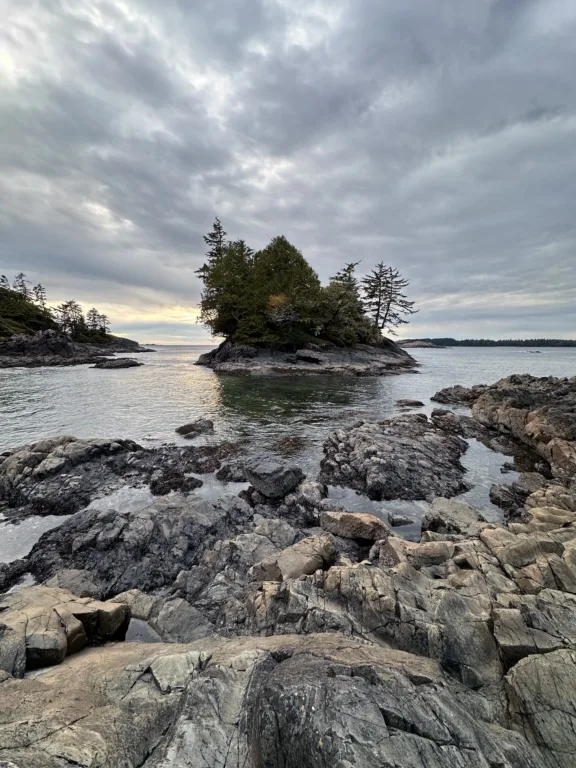
Biking the ʔapsčiik t̓ašii Trail
Pronounced ups-cheek ta-shee, the ʔapsčiik t̓ašii trail is a new multi-use trail that runs through Pacific Rim National Park and connects to multi-use paths in Tofino and Ucluelet on either end. The trail’s name means “going the right way on the path” in Nuu-chah-nulth.
If you’re into biking, riding the trail is a great way to get to the beaches and see a bit of the coastal rainforest.
We rented bikes from Tofino Bike Co. in the same complex as Tacofino. They are open a few days a week in fall and spring but close completely over the winter so check hours ahead of time.
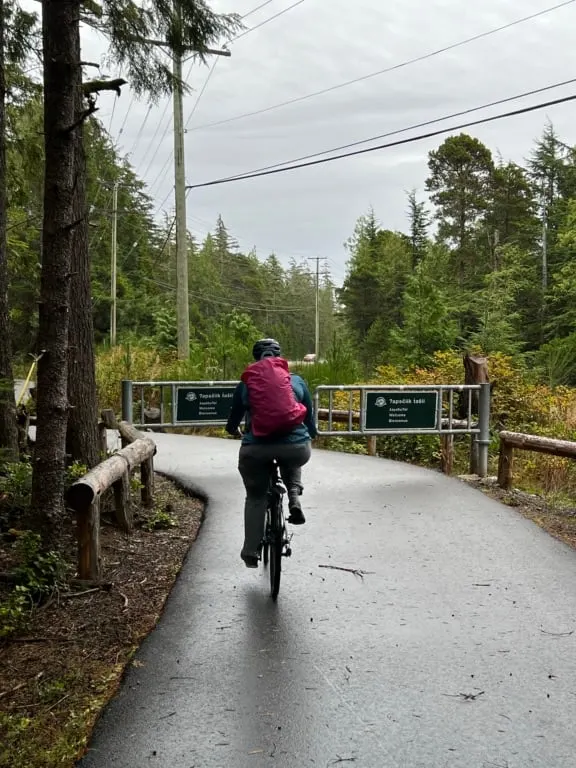
We followed the path south from the bike rental shop. It runs beside the highway until it gets into the National Park, where it dips further into the forest.
I liked that section the best because it was more winding and I felt immersed in the rainforest. The landscape reminded me of the boggy coastal forests at Cape Scott… except instead of hiking through mud I was breezing through on a bike on a paved path!
We spotted some culturally modified trees (CMTs) along the trail. Many Indigenous groups in BC, including the Tla-o-qui-aht, sustainably harvest cedar bark in strips in a way that does not harm the tree. They process the bark, then weave it into hats, baskets, and other items. It’s cool to see this traditional practice continue today.
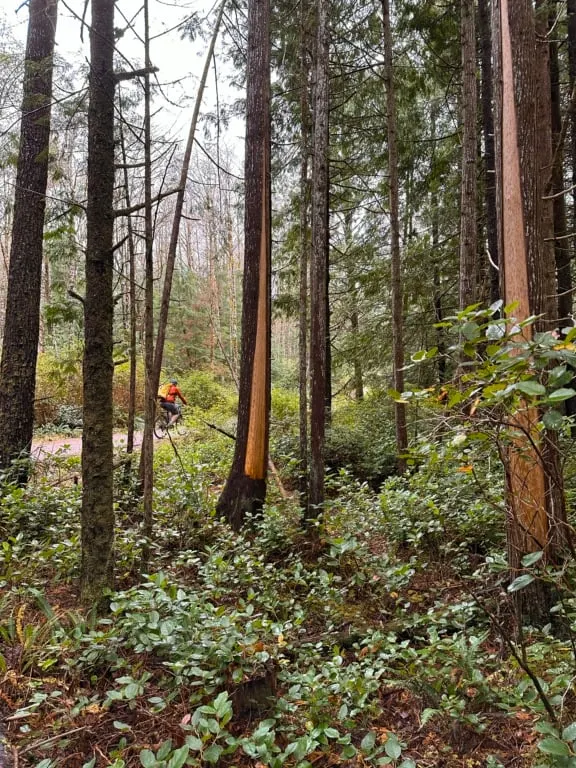
We ended up biking to Incinerator Rock on Long Beach and back, with a stop at Chesterman Beach for a quick walk break. (There are bike racks at all beach access points.)
The trail is open all winter but is not maintained so you can expect some fallen branches from wind storms. Also, be careful on the wooden bridges because they can be slippery.
Boutiques and Galleries
One of my favourite things to do in Tofino, especially on rainy days, is to browse the boutiques and galleries. Tofino doesn’t have any chain businesses, so each shop is so unique with lots of locally made goods. Most shops are downtown along Campbell Street, but there are a few others spread out elsewhere.
I always stop at Mermaid Tales Book Shop to browse for books about Vancouver Island’s history. They also have a great selection of plant guides and other natural history books along with lots of fiction and a good kids section.

Caravan Beach Shop is a beautifully curated boutique. They have beachy and West Coast-inspired home goods, clothing, accessories, and art.
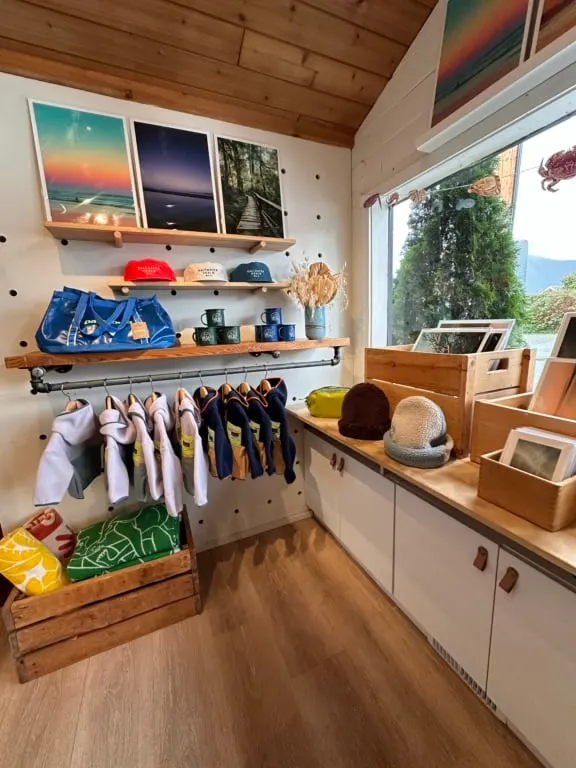
If you’re looking for Indigenous art, you can’t miss the Roy Henry Vickers Gallery. It’s located in the huge long house-style building on Campbell Street. He is one of the most prominent Indigenous artists in Canada – you can find his distinctive prints all over BC. I have one hanging in my living room that I inherited from my Great Aunt who loved going to Tofino in the 1980s when the gallery was first opened.
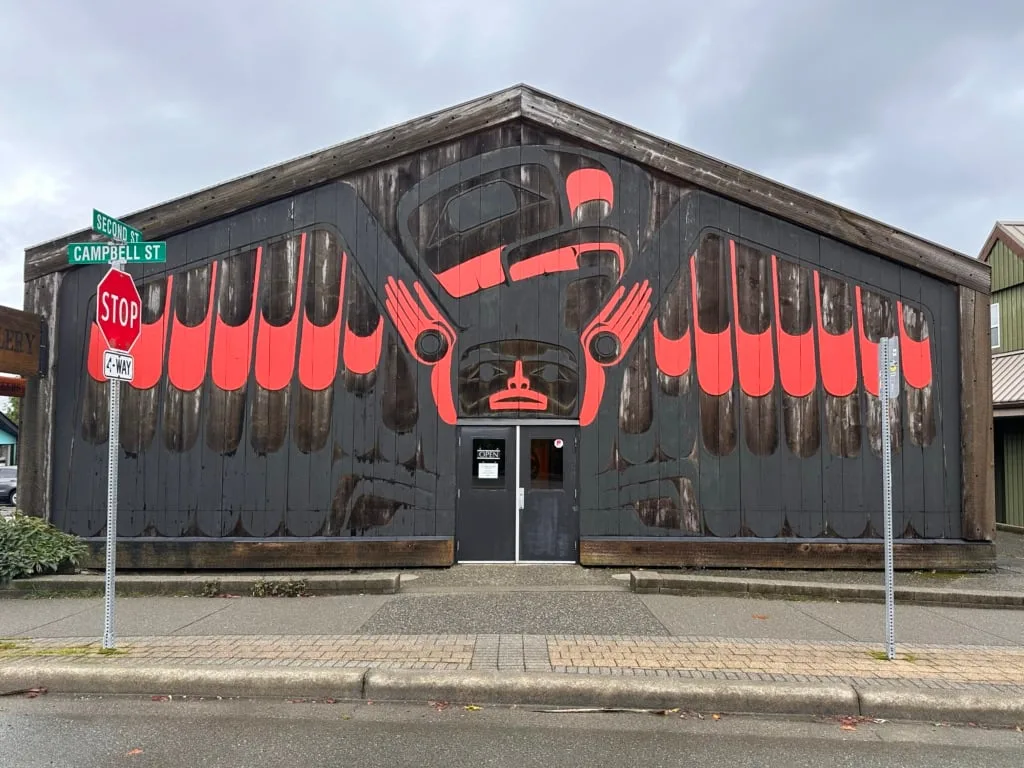
Another place that I always stop, even though it isn’t downtown, is Chocolate Tofino. It’s in the Live to Surf plaza (near Tacofino.) They make beautiful handcrafted ethically sourced chocolates. You can buy bars or gift boxes, but I do their pay-by-weight option and get just the flavours I want.
Where to Eat in Tofino
For a small town, Tofino has a surprisingly good foodie scene. I always make time to eat out when I’m in town. Below I’ve got my picks for the best coffee shops, food trucks, and restaurants.
Coffee Shops
Part of the charm of cozy season in Tofino is getting a cup of coffee to go and taking it for a walk along the beach. I pack my YETI Rambler mug because it keeps my coffee warm for literally hours. Plus, it cuts down on wasteful disposable cups.
Rhino Coffee
In downtown Tofino, I like Rhino Coffee. If you’re hungry, they make great breakfast sandwiches. Their doughnuts are also great.
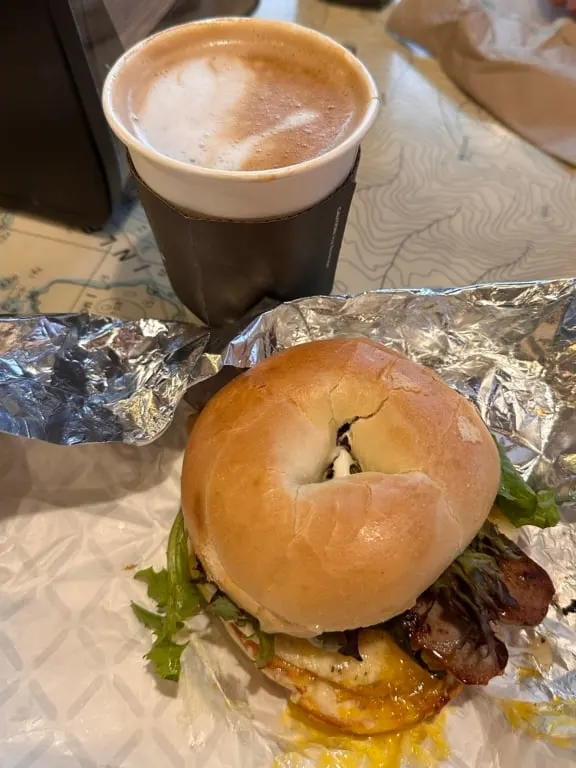
Tofitian Cafe
If you’re on the way to the beach, Tofitian Cafe in the Live to Surf plaza is also good. If you’re paying attention, you’ve seen their signature skull motif Tofitian stickers all over BC.
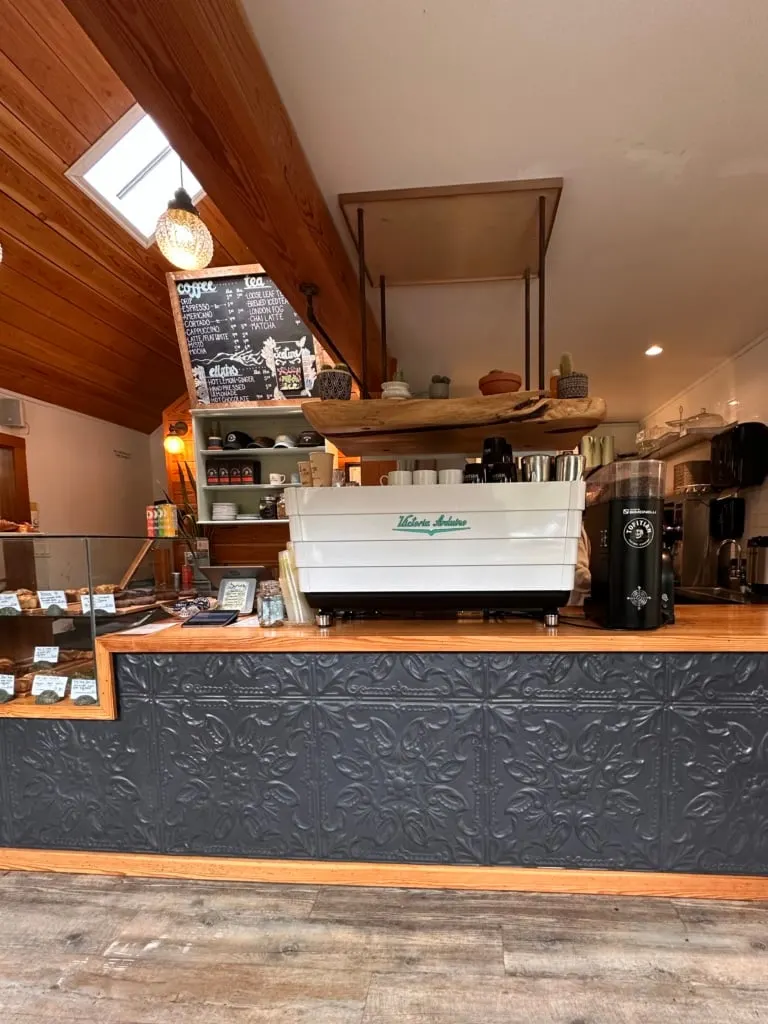
Food Trucks
For a casual lunch, a food truck is the way to go. Some have a bit of covered outdoor seating, but in the winter, bring a jacket in case it gets cold. Or be prepared to eat in your car.
Tacofino
By far the most famous food truck in Tofino is Tacofino, located at the back of the Live to Surf plaza. While today they have 12 locations across Vancouver and Vancouver Island, it all started in this humble, sticker-covered van.
In the summer there are long lines (up to an hour!) but in the winter you can breeze through quickly. Their fish tacos are incredible.
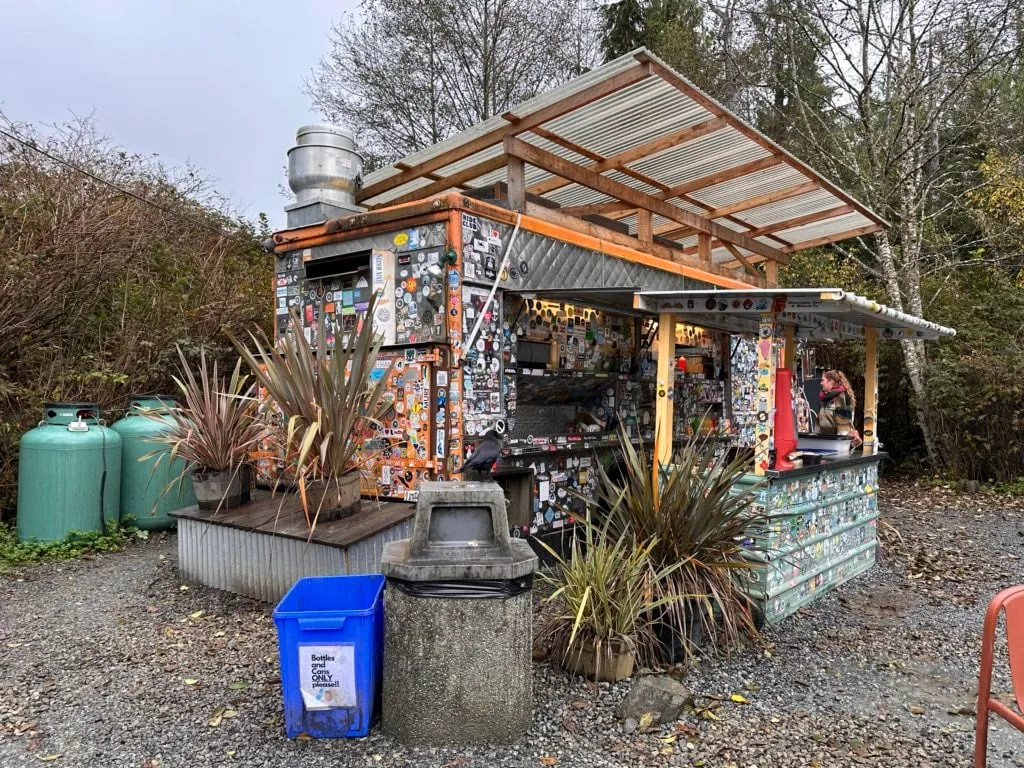
Wildside Grill
Recently, I finally tried Wildside Grill, also in the Live to Surf plaza. It’s more a food stand than a truck. They make classic fried things: burgers, fries, fish and chips, etc. But they also have great soups and tacos.
The best thing to order is anything with fish – I had a great fish taco and some amazing seafood chowder. They have a few covered tables if its raining.
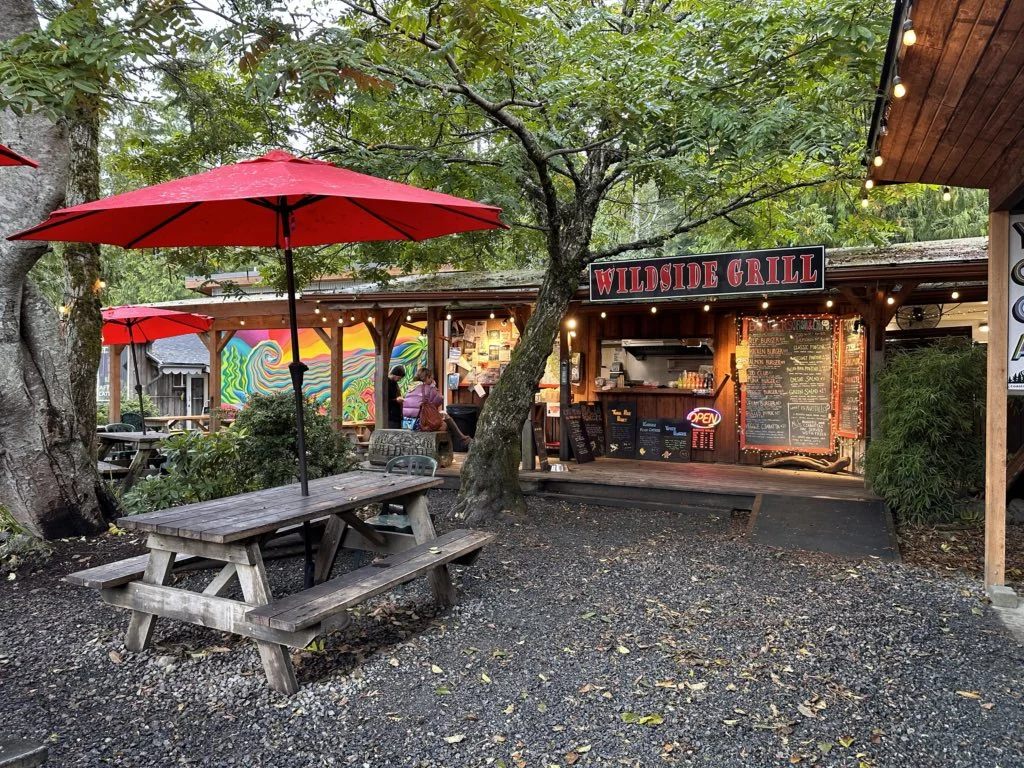
Restaurants
If you’re a foodie, you’re spoiled for choice in Tofino. Many of my winter trips to Tofino have coincided with my wedding anniversary, so we usually go out for at least one special, splurge meal while we are there. Here are a few of my favourite spots.
Shelter
The first time we went to Tofino for our anniversary we had dinner at Shelter. It’s one of Tofino’s oldest and most beloved restaurants. After a devastating fire a few years ago, they reopened in a stunning new waterfront location.
The menu is mostly elevated takes on classic dishes like tempura lingcod fish and chips or seared wild sockeye salmon. The red Thai coconut curry I ordered had so many types of seafood!
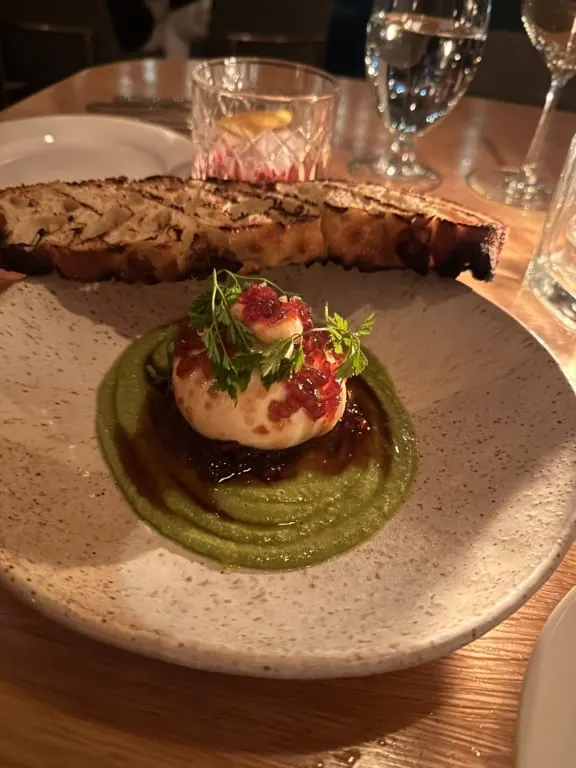
Wolf in the Fog
For true foodies or a special occasion, I recommend Wolf in the Fog. The emphasis is on local cuisine, especially seafood. They have a great cocktail menu, including some great zero-proof options for non-drinkers like me.
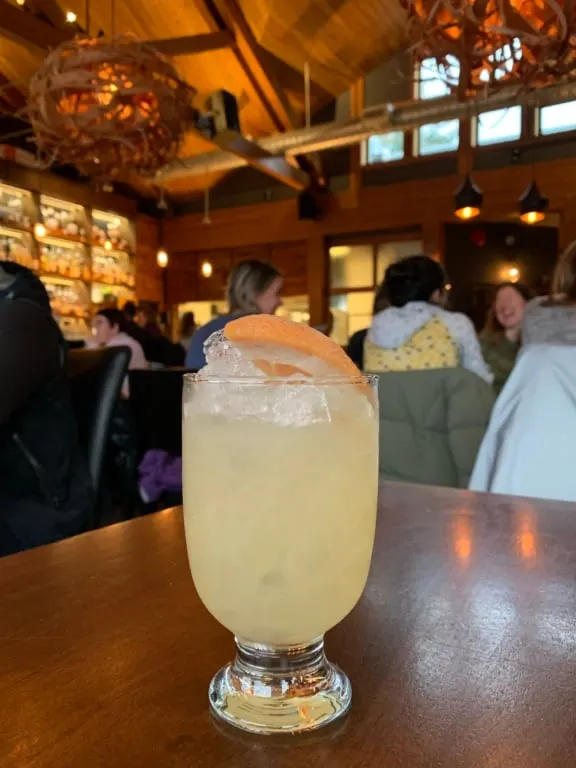
Ombre
On my last trip, I ate at Ombre, which just opened this past summer and is owned by the same people as Wolf in the Fog. I was really impressed with their menu of shareable small plates. Both the duck leg and the octopus were so good!
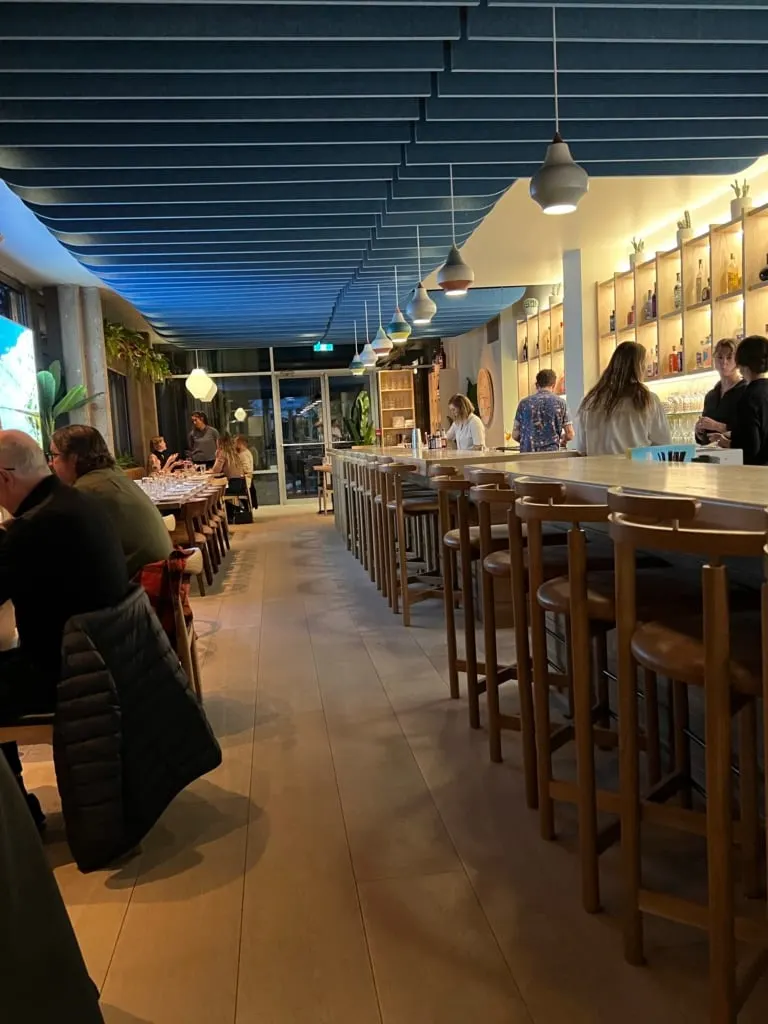
Jeju
I also ate at Jeju recently. What a unique experience! This tiny restaurant is run by a mother and son. Their small menu includes Korean classics on mom’s side of the menu and innovative fusion take on Korean food on the son’s side of the menu. The upscale bulgogi with truffles and rib eye steak was insanely good.
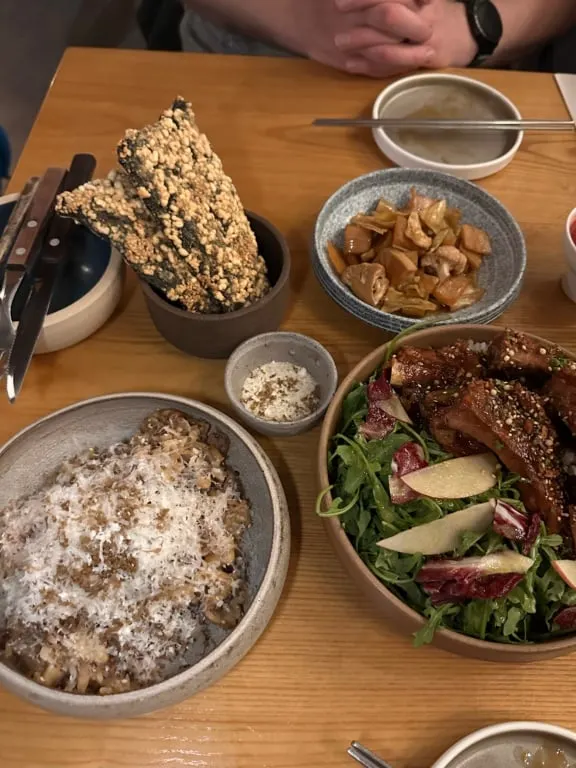
The Bear Bierhouse
If you’re looking for something more casual, head to the Bear Bierhouse inside the Maq Hotel. It’s a sports bar with lots of German beers on tap.
But it also has one of the best burgers I’ve ever had in Canada. The chef explained that’s because they hand-chop their beef instead of grinding it, which allows them to serve their burgers medium instead of well-done. So juicy! The indoor/outdoor bear sculpture is also fantastic for photos.
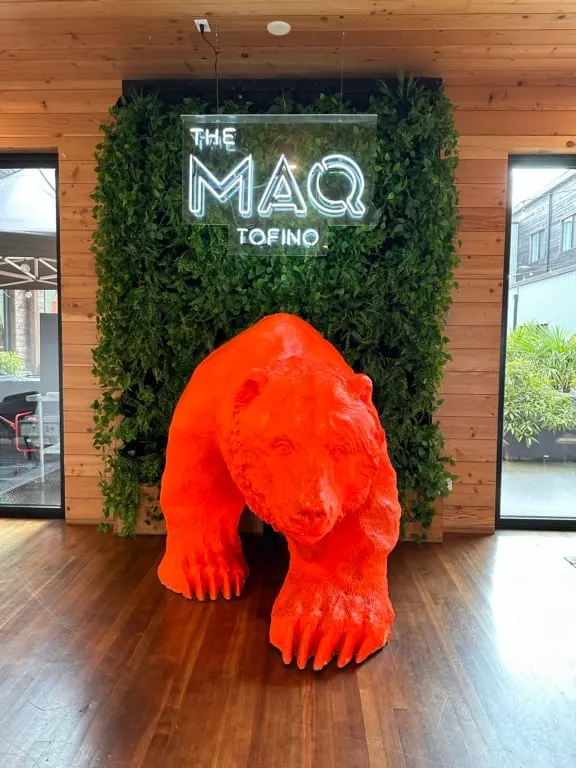
Tofino Brewing
My husband loves craft beer, so we always stop at Tofino Brewing each time we are in town so he can try a flight of their latest brews. This time his favourite was the Kelp Stout, a strong and dark beer, perfect for winter.
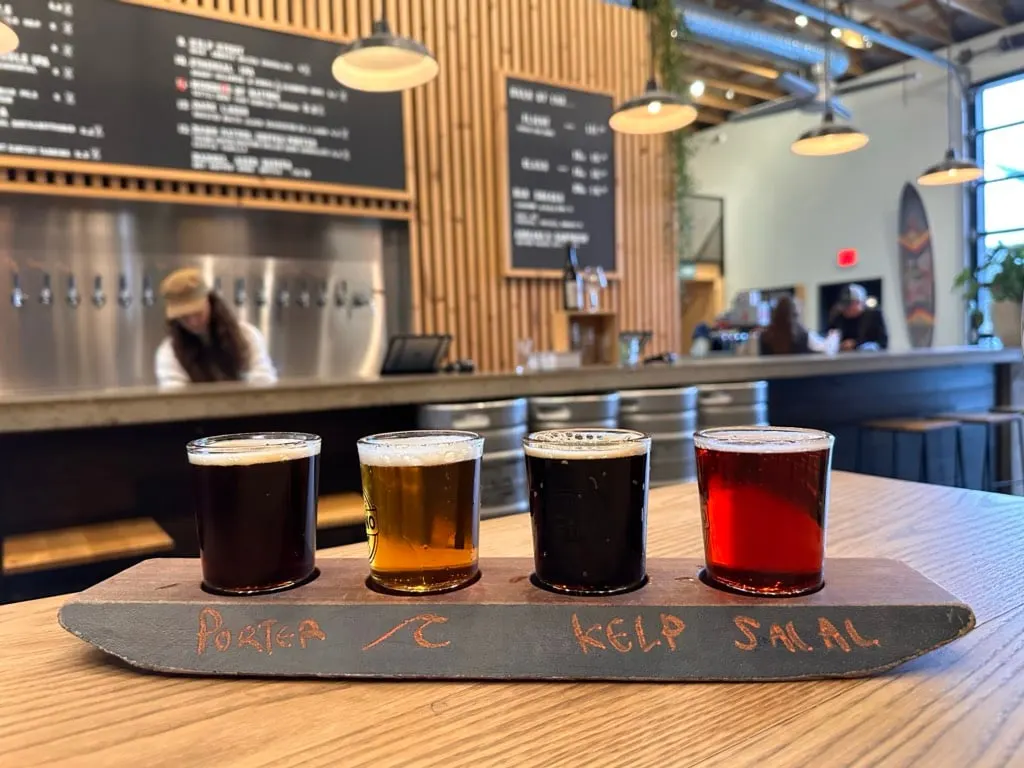
Where to Stay in Tofino
There are tons of accommodation options in Tofino. Most are outside of town near the beaches, but there are a few options in town. Accommodation prices in the summer can be outrageous, but in the winter, even beachfront options get more affordable. Here are some places I recommend.
Mackenzie Beach Resort
On my last trip, we stayed in an adorable modern tiny house at the Mackenzie Beach Resort. The resort is right on Mackenzie Beach and they have a little cafe on site.
Our tiny house was small, but had a mini kitchenette and a great outdoor space including an outdoor shower (which helped get the sand off after my surf lesson). And the decor was really cute in a West Coast minimalist way.
They also have cabins and really cool renovated airstreams you can stay in. And if you have an RV, they have year-round RV campsites.
Compared to more upscale resorts, the prices here are really reasonable. Check rates.
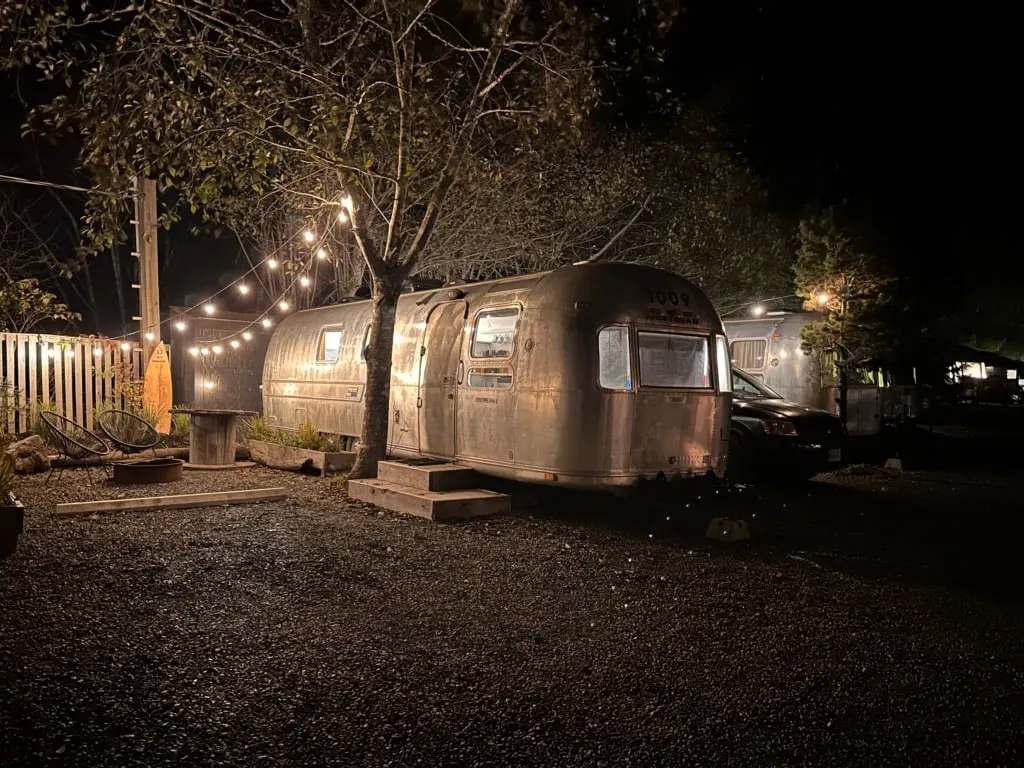
Ocean Village Resort
The picturesque beehive-style cabins at Ocean Village Resort are also on Mackenzie Beach. They were built in 1976, so they have a fun retro vibe. But don’t worry, they’ve been modernized and the resort is committed to sustainability with a composting program and on-demand hot water. Check rates.
The cabins at Ocean Village are one of my picks for the best cabins near Vancouver.
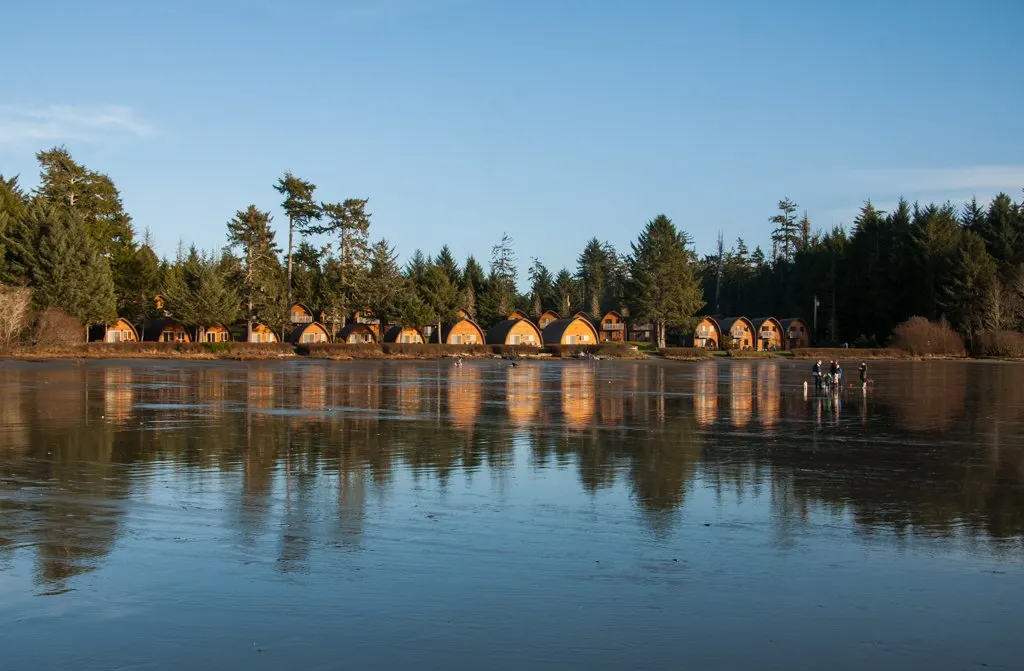
Cox Bay Beach Resort
If you’re with a group, the two-bedroom suites at Cox Bay Beach Resort are great. A few years ago I spent a long weekend here with my sister and some friends. The suites sleep six and have full kitchens so you can make your own meals. Plus they are right on Cox Bay. Check rates.
Pacific Sands Beach Resort
If you want to splurge, book a suite at Pacific Sands Beach Resort. Most suites have incredible ocean views of Cox Bay Beach. My very first trip to Tofino in the 1980s was to Pacific Sands. Back then we stayed in a rustic cabin, but over the years the resort has been completely redone.
Now, the basic cabins are long gone and they have a variety of luxe suites, on-site saunas, a spa, firepits, a cafe, and lots more amenities. Check rates.
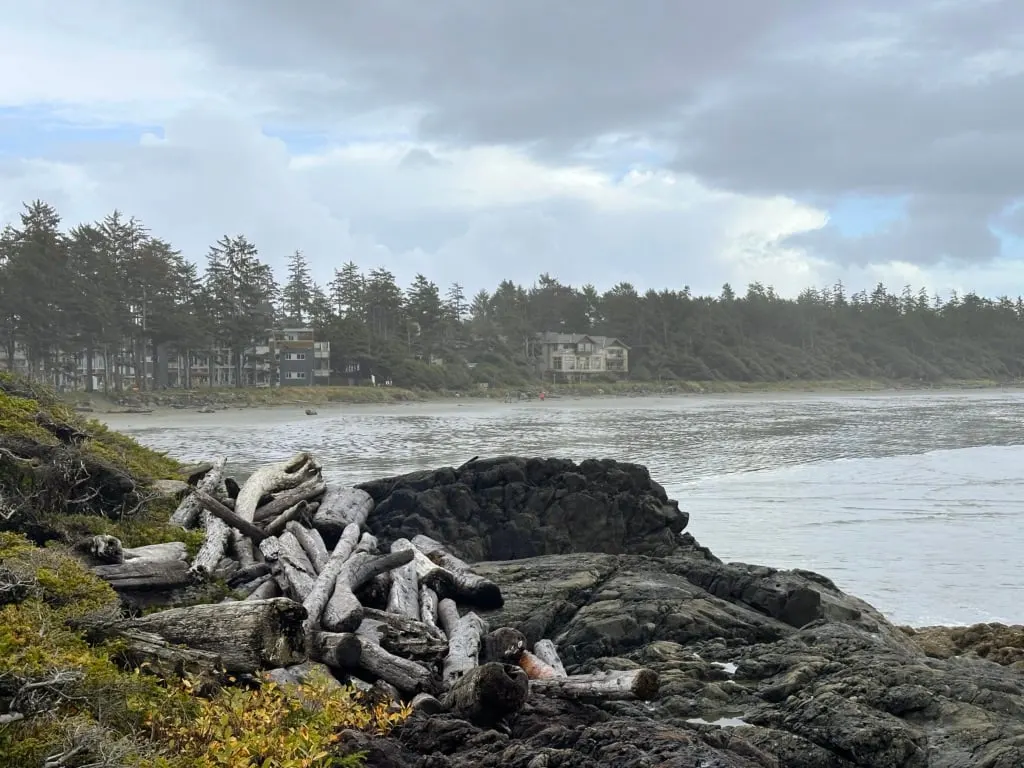
Guest Houses and Vacation Rentals
Tofino has a housing shortage and locals who need to live in town to work in the tourist sector often struggle with affordable housing and housing insecurity. For that reason, there aren’t that many guesthouses or vacation rentals compared to hotels.
I’ve stayed in a few great vacation rentals over the years, both in the town of Tofino and near the beaches. If you’re looking for a vacation rental on VRBO or Airbnb, be sure to read the listing to check for a business licence number. That ensures that you are renting from a legal business and are not contributing to the housing crisis.
Winter in Tofino Basics
In this section I’ve got practicalities for a winter visit to Tofino including getting there, getting around, what to pack, and more.
How to Get to Tofino
Tofino is located on the isolated west coast of Vancouver Island. The easiest way to get there is to drive yourself.
You can fly directly to Victoria or Nanaimo airports on Vancouver Island and then rent a car and drive from there. I use Discover Cars to book rental cars since it lets me compare prices across different companies.
If you’re coming from Vancouver, you’ll need to take BC Ferries. You have two options: The ferry from Horseshoe Bay in West Vancouver to Departure Bay in Nanaimo is closer if you’re coming from downtown Vancouver. If you’re coming from the Vancouver airport, the ferry from Tsawassen to Duke Point in Nanaimo is more convenient.
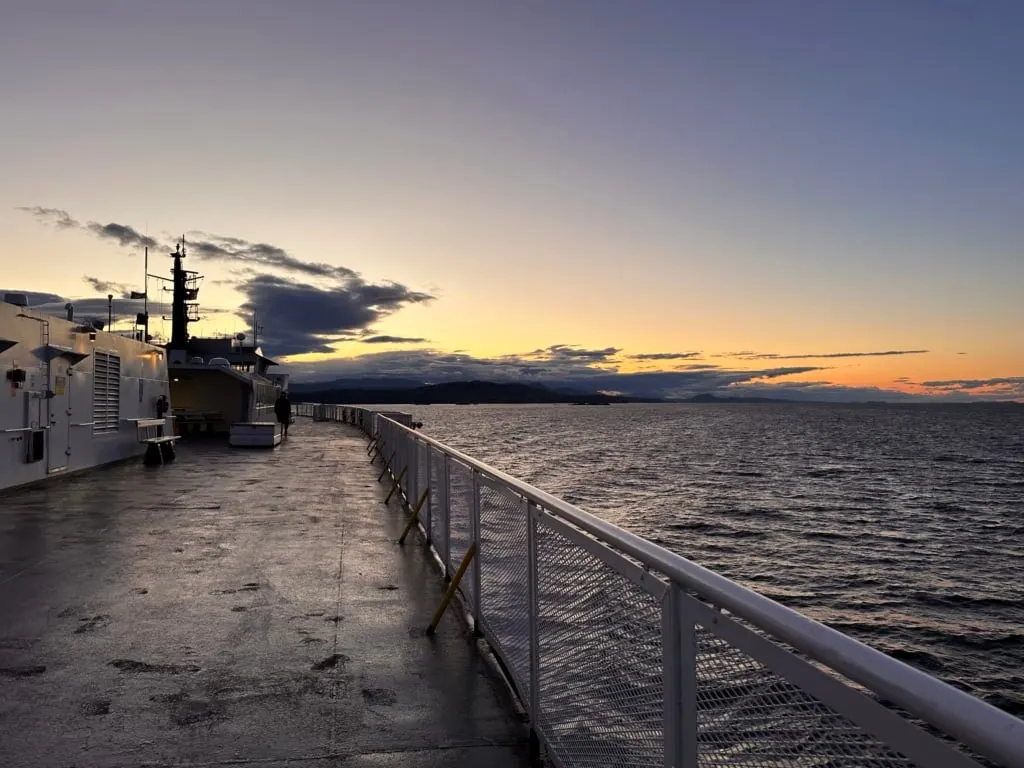
It’s a 3-hour drive from Nanaimo via Highway 19 and Highway 4. From Victoria, it’s a 4.5-hour drive via Highways, 1, 19, and 4.
The drive is usually fairly straightforward (although the road is very curvy). However, it does go over two small passes on Highway 4 that get snow a handful of days each winter. Check road conditions on Drive BC before you go and make sure that your car has M+S or snow-rated tires, which are required by law between October and April.
Make time on your drive to stop at Cathedral Grove in MacMillan Provincial Park to take a walk past the giant old-growth trees. Port Alberni also makes a good stop for lunch or a snack. I recommend the Wildflower Bakeshop & Cafe or the sushi at Sehmi.
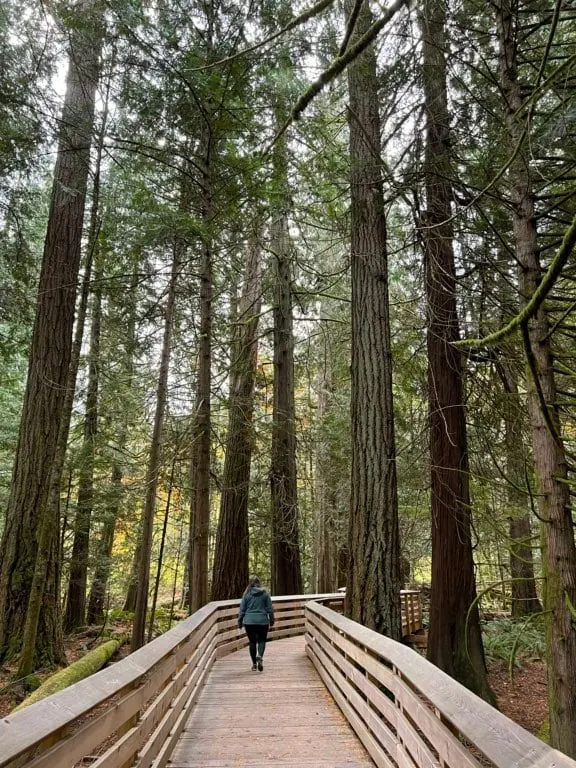
Getting Around Tofino
If you’re visiting Tofino in the winter, having a car will make your trip a lot more enjoyable. Many of the hikes and beaches are spread out, so a car is handy.
If you are driving, keep in mind that many places have paid parking. You’ll need to pay to park at the beaches and in National Park parking lots. While you have to pay for street parking in downtown Tofino during the summer, it is free in the winter between November and April.
While there is a free shuttle bus in the summer, it only runs from late June to early September. The rest of the year you can take the local bus, West Coast Transit. It runs between Tofino and nearby Ucluelet. However, it doesn’t run very often and you’ll have to walk quite far from a stop to many beaches and hikes.
How Long to Spend in Tofino in Winter
In the winter, a long weekend is the perfect amount of time to spend in Tofino. That’s enough time to do a few activities like a surf lesson, a kayak tour, or a trip to Hot Springs Cove, but still leaves enough time for leisurely beach walks or chill rainforest hikes.
Winter Weather in Tofino
Tofino is on Vancouver Island’s west coast. The weather blows in from the Pacific Ocean, which means that rain and storms are common. However, that also means that is never very cold.
The average temperature between November and March is between 3°C and 10°C (37 to 50 F°). Expect rain if you visit in winter – it rains between 16 and 20 days a month. However, while it can be very rainy some of the time, on most days, it rains for a few hours and is cloudy (or even sunny) for the rest of the day.
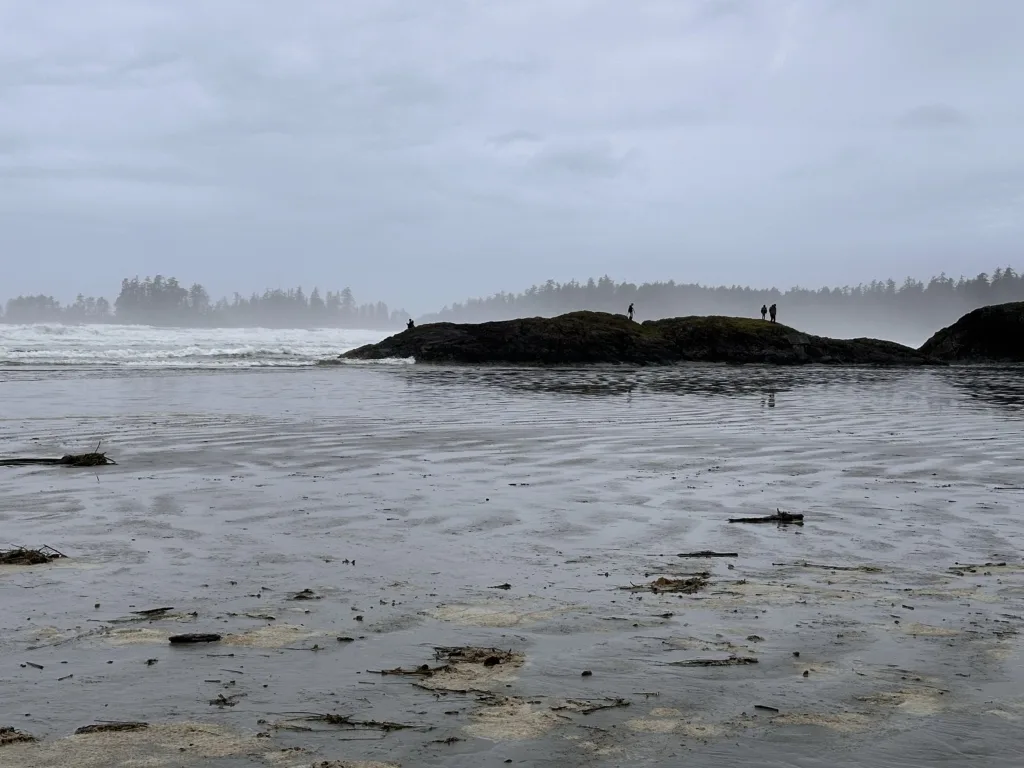
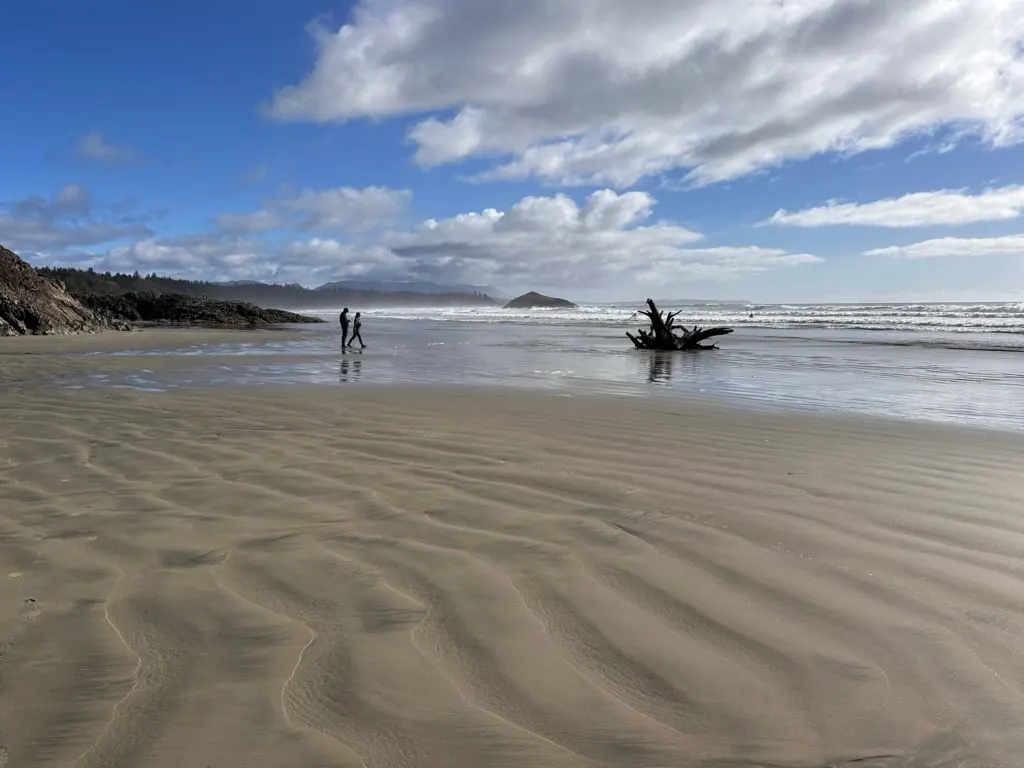
What to Pack for Winter in Tofino
Tofino is a pretty laid-back place, so you don’t need to bring anything fancy. Even if you go out for a fine dining dinner, nice jeans and a sweater are fine.
Make sure you bring clothing for the weather. A rain jacket is key, along with warm layers to wear underneath like a fleece or lightweight puffy jacket.
Waterproof hiking boots are great if you’re planning to hit the trails. If you own a pair of rain boots, pack them. I bring my favourite ankle-height Xtratufs to wear for beach walks or on rainy walks around town.
Don’t forget to pack a bathing suit and towel for surfing, the hot springs, or your hotel hot tub.
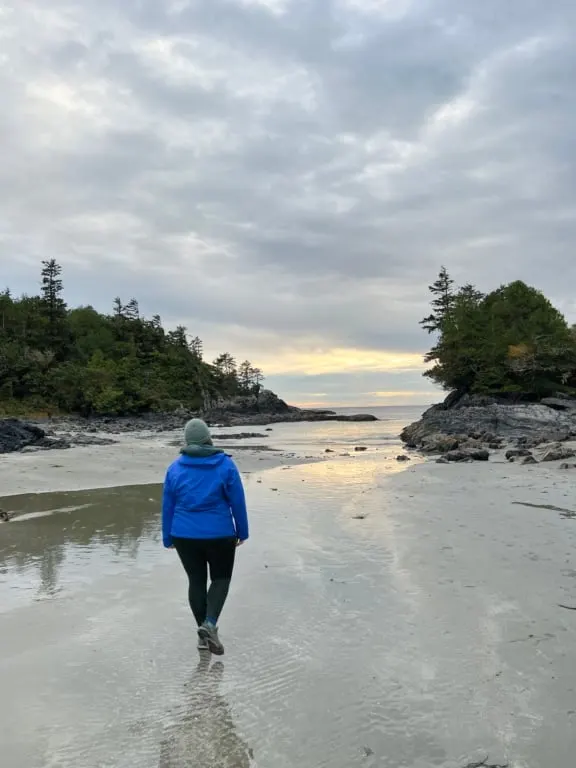
Indigenous Context in Tofino
Tofino is the traditional territory of the Nuu-chah-Nulth peoples. Nuu-chah-nulth means “all along the mountains and the sea”. Today the Nuu-chah-nulth Tribal Council is made up of 14 First Nations including the Tla-o-qui-aht whose territory is in what is now Tofino.
Before colonization, the Nuu-chah-nulth lived in a series of seasonal village sites along the coast. But like most Indigenous people in North America, their culture and way of life was severed by residential schools and racist colonial policies.
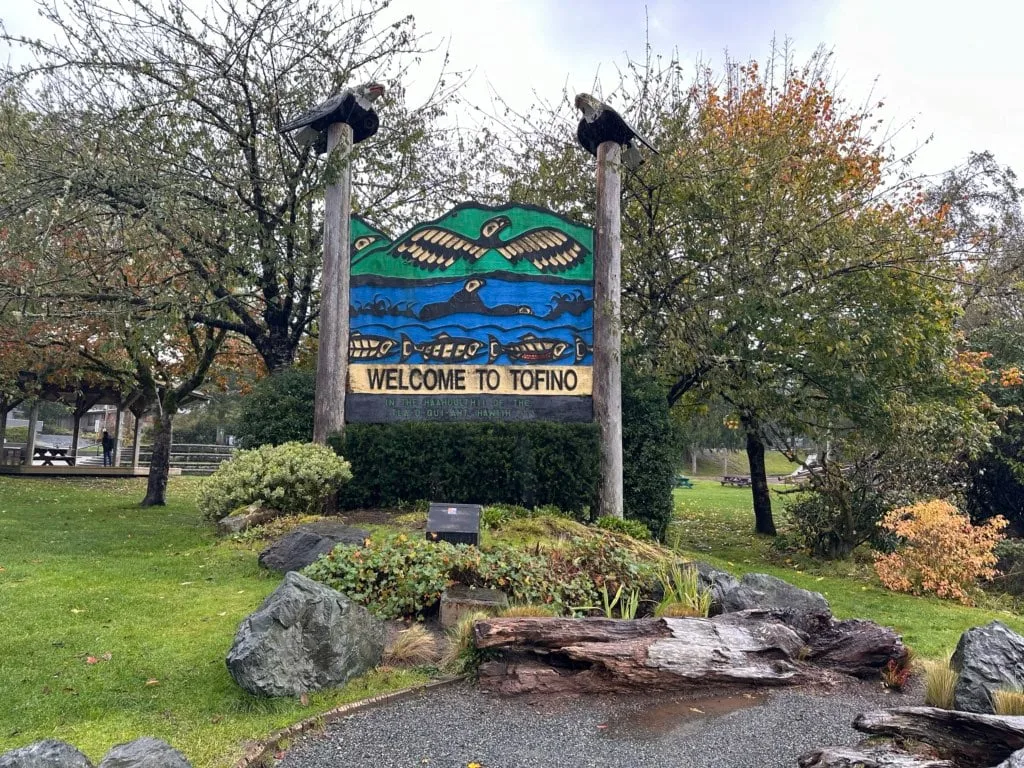
Tribal Park Allies Program
Today the Nuu-chah-nulth are working to regain management of their traditional territories. One of the ways to support that work is through the Tribal Park Allies program. Participating businesses in Tofino collect a 1% fee from their customers.
This money goes towards Nuu-chah-nulth community and environmental projects like removing waste from beaches, enhancing salmon-bearing streams, planting trees, and conserving vulnerable ecosystems.
Many of the businesses I highlight in this post are Tribal Park Allies: Rhino Coffee House, Paddle West Kayaking, Mermaid Tales Book Shop, and Tourism Tofino.
ʔiisaak Pledge
The best way to be respectful of Tla-o-qui-aht territory is to read and follow the ʔiisaak Pledge. Like many coastal Indigenous peoples in BC, the Tla-o-qui-aht have a long tradition of hosting visitors. However, guests must show respect for their land and traditions.
In the Tla-o-qui-aht language, the concept of ʔiisaak means to observe, appreciate, and act accordingly. The ʔiisaak pledge includes guidance on how to respect the natural world, Tla-o-qui-aht history, and the local community.
Final Thoughts
I love Tofino in the winter and if you haven’t been yet, I think you’re missing out on something special. Pack your rain gear, book a cozy cabin or oceanview suite and go! If the weather sucks, all the better because you’ll get some amazing storm watching.
If you have questions about planning a trip to Tofino in the winter, ask in the comments. I’d love to help.
READ NEXT:
- Hiking the Big Tree Trail on Meares Island
- Pacific Marine Circle Route Road Trip Guide
- Where to Experience Indigenous Tourism in Canada
- Things to do on Northern Vancouver Island
- Bowron Lakes Canoe Circuit: 2026 Paddling Guide - November 20, 2025
- 2026 BC Backpacking Reservation Dates You Need to Know - November 20, 2025
- 2025 Black Friday Deals for Hikers - November 19, 2025

